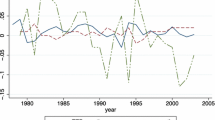Abstract
Changes in the size of establishments — as opposed to the turnover of workers across a given set of jobs — account for a non-negligible component of gross workers flows. Based on a rich database of establishment-level employment records in western Germany, this paper analyses the magnitude and determinants of job turnover and its relation with labour turnover. Consistently with findings from other countries, it is shown that job turnover is mainly the byproduct of the dispersion of establishment-level outcomes within any industry rather than of job reallocation across different sectors. The role played by disturbances to consumer preferences over differentiated products is also assessed in an attempt to shed some light on the determinants of this tremendous heterogeneity of establishment-level employment changes within each industry.
Similar content being viewed by others
References
Berry, C. H., 1971, ‘Corporate Growth and Diversification’,Journal of Law and Economics 14(4), 371–383.
Boeri, T., 1990, ‘Homogenization, Specialization and the Sharing of Output Growth between Incumbents and Entrants’, CV Starr Center for Applied Economics Working Papers, number 49.
Boeri, T. and U. Cramer, 1992, ‘Employment Growth, Incumbents and Entrants: Evidence from Germany’,International Journal of Industrial Organization 10(1), 63–71.
Burda, M. and C. Wyplosz, 1993, ‘Gross Worker and Job Flows in Europe’, mimeo, INSEAD Business School.
Cramer, U. and M. Koller, 1988, ‘Gewinne und Verluste von Arbeitsplaetzen in Betrieben — der “Job Turnover” — Ansatz’,Mitteilungen aus der Arbeitsmarkt und Berufsforschung 21(3), 361–377.
Davis, S. J. and J. Haltiwanger, 1990, ‘Gross Job Creation and Destruction: Microeconomic Evidence and Macroeconomic Implications’,NBER Macroeconomics Annual 5(2), 123–168.
Davis, S. J. and J. Haltiwanger, 1992, ‘Gross Job Creation, Gross Job Destruction, and Employment Reallocation’,Quarterly Journal of Economics 72(3), 819–863.
Dunne, T., M. J. Roberts and L. Samuelson, 1989, ‘Plant Turnover and Gross Employment Flows in the US Manufacturing Sector’,Journal of Labour Economics 7(1), 48–71.
Ericson, R. and A. Pakes, 1988, ‘Empirical Implications of Alternative Models of Firm Dynamics’, paper presented at the NBER Conference on Dynamic Aspects of Firm and Industry Behaviour, Cambridge.
Gollop, F. M. and J. L. Monahan, 1991, ‘A Generalized Index of Diversification: Trends in US Manufacturing’,Review of Economics and Statistics 70(3), 318–330.
Grey, A., 1993, ‘Job Creation and Job Destruction: An Overview of Recent Literature and Directions for Research’, mimeo, OECD.
Hopenhayn, H. A., 1992, ‘Exit, Selection, and the Value of Firms’,Journal of Economic Dynamics and Control 16(1), 621–653.
Jovanovic, B., 1982, ‘Selection and Evolution of Industry’,Econometrica 50(4), 649–670.
Jovanovic, B. and S. Lach, 1989, ‘Entry, Exit, and Diffusion with Learning by Doing’,American Economic Review 79(5), 690–699.
Leonard, J. S., 1988, ‘Firm and Establishment Growth and Stability’, paper presented at the NBER Conference on “Dynamic Aspects of Firm and Industry Behaviour”, Cambridge.
OECD, 1987,Employment Outlook, Paris.
Streitweiser, M. L., 1991, ‘The Extent and Nature of Establishment-Level Diversification in Sixteen US Manufacturing Industries’,Journal of Law and Economics 61(4), 503–534.
Violante, G. and A. Prat, 1992, ‘Cyclical Aspects and Firms Heterogeneity in Job Reallocation: Evidence from Italian Data’, mimeo, Turin.
Author information
Authors and Affiliations
Additional information
The views expressed herein are those of the author and do not necessarily reflect those of the OECD. The author would like to thank Boyan Jovanovic and an anonymous referee for useful comments on an initial draft.
Rights and permissions
About this article
Cite this article
Boeri, T. Why are establishments so heterogeneous?. Small Bus Econ 6, 409–420 (1994). https://doi.org/10.1007/BF01064856
Received:
Issue Date:
DOI: https://doi.org/10.1007/BF01064856




